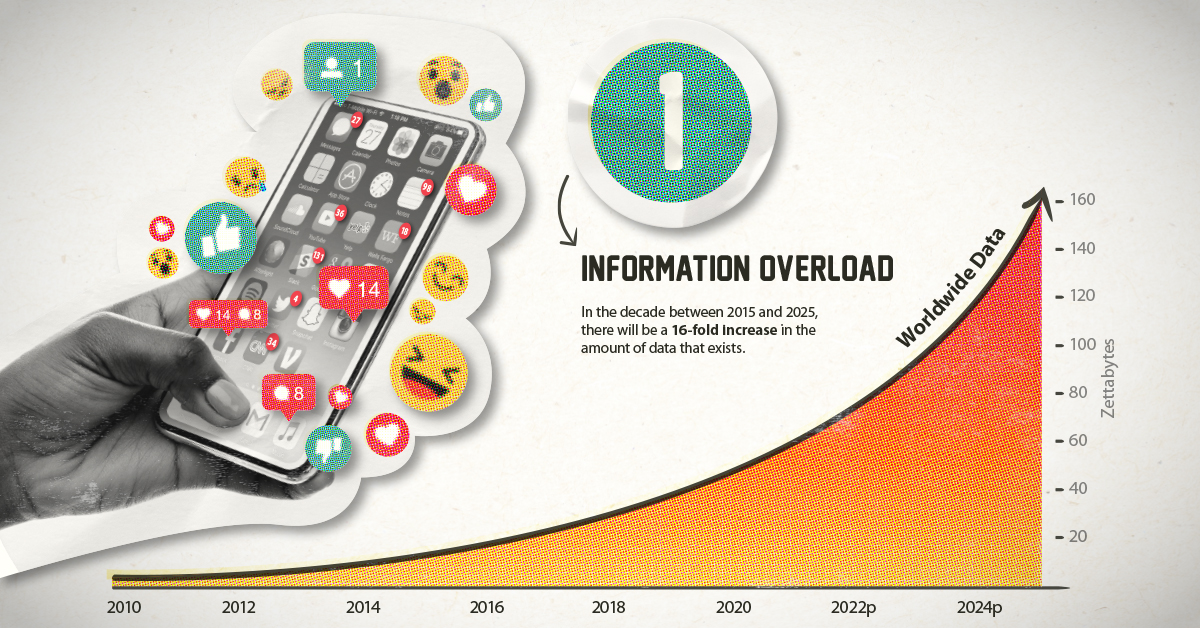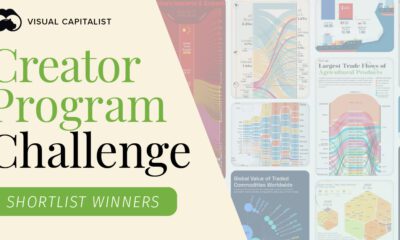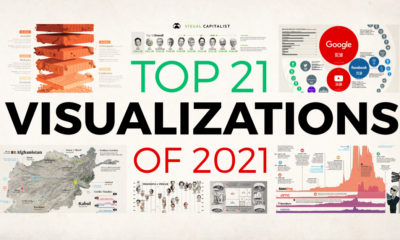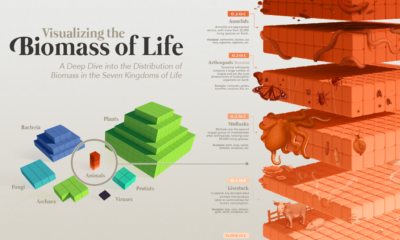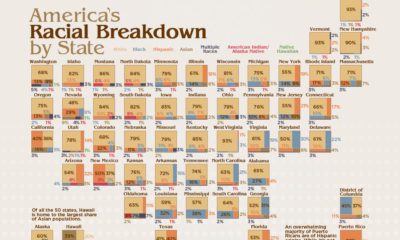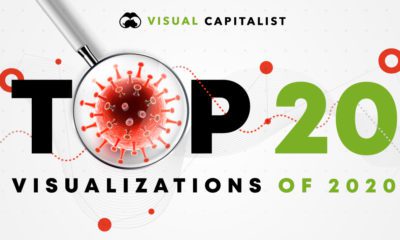Misc
5 Megatrends Fueling the Rise of Data Storytelling

Infographic: The Rise of Data Storytelling
Humanity is creating more data than ever before, and more of that data is publicly accessible.
While “data is the new oil” has almost become a cliché, the impact that data abundance is having on the world is undeniable. All of the world’s most valuable companies are heavily reliant on data for their continued success. Even oil giant Saudi Aramco, the world’s most valuable company, runs a 6,000 m² data center, and is partnering with Google Cloud.
In a world where nearly everything is quantified, communicating insights from that data becomes a massive opportunity. This is where data storytelling comes in. In simple terms, it’s the difference between simply making a chart, and actually explaining what it means, why it’s important, and how it fits into the broader context. This style of data-driven communication is cropping up everywhere, from newsrooms to corporate communications.
Here, we examine five megatrends fueling the rise of data storytelling.
① Information Overload
It’s estimated that between 2015 and 2025, the world will see a 16-fold increase in data.
- The bad news: The rising tide of information is growing faster than our ability to harness it
- The good news: This growing universe of data holds the promise of more insight, if properly utilized
Thankfully, data storytelling is an emerging field that thrives on information abundance.
As our society and economy grow more complex, more high-quality, actionable information is critical for today’s decision makers.
② Declining Trust in Media
Trust in news media has been declining for decades, and in many countries around the world, the majority of people don’t feel that media is a trustworthy source of information.
Trust in social media is similarly shaky. Only one-third of people surveyed around the world believe that social media is a trustworthy source of information. As well, a recent poll found that 75% of U.S. adults felt that political views were likely being censored by social media platforms.
The mass media ecosystem as it currently exists is facing a crisis of confidence. When a system is no longer adequately serving the needs of its users, that system is ripe for disruption.
③ Winner-Take-All Dynamics
This information abundance should be propelling humankind forward, but more often than not, valuable insights are lost in the noise—either poorly presented or pushed to the margins by clickbait and other distractions.
Today, most of us rely on algorithms and aggregators to deliver information to us. Over time, those systems become very good at feeding us information that is generally what we’re looking for. The downside, however, is that engagement-driven algorithms reward only the most compelling narratives. The handful of stories you see are the result of fierce, darwinistic competition on platforms like Twitter or Medium.
This hyper-competitive environment is part of the reason there are so many problems with media today—clickbait and tabloidization being two prominent examples.
Data storytelling takes potentially dry, complex topics and makes them more accessible, compelling, and more likely to win the battle for people’s attention.
④ Moving Beyond Text
Many of our existing systems look the way they do in part because of past technological limitations.
Search engines, for example, are still largely driven by text-based considerations. This makes sense as the early internet was essentially a collection of pages with text and hyperlinks.
Today, search engines are much better taking other forms of information into consideration, and technological advancements are breaking new ground in analyzing video and data visualizations. Advancements in AI could soon allow users to search for visualizations in ways that don’t even involve text keywords.
In a future where searching for information in a visual format is as intuitive as a Google search today, the utility and reach of data storytelling will increase dramatically.
⑤ Democratization of Data Storytelling
Even as the number of people with professional credentials in data analytics, data science, and other similar professions is on the rise, it’s never been easier for laypersons to create and publish high quality visualizations.
Free tools which are usable on almost any device have broken down barriers of access for millions of people around the world. There is now a universe of resources for people and organizations looking to convert data into a compelling visual format.
Below is a shortlist of data storytelling resources ranging from the intuitive design tools to powerful coding language libraries:
| Resources for getting started | |||
|---|---|---|---|
| Visualization selection | Data Viz Project | From Data to Viz | Storytelling With Data |
| Color selection | Adobe Color CC | Paletton | Colors on the Web |
| Beginner friendly | Infogram | Piktochart | Venngage |
| Bringing data to life | |||
|---|---|---|---|
| Classic | Microsoft Excel | Adobe Creative Suite | Google Data Studio |
| BI-focused | PowerBI | Tableau | Domo |
| Web apps | RAW Graphs | Flourish | Datawrapper |
| Powerful, specialized resources | |||
|---|---|---|---|
| JavaScript libraries | d3.js | Chart.js | HighCharts |
| Mapping | ArcGis | MapBox | Polymaps |
| Programming languages | R | Python | Matlab |
Of course there are many more resources out there, and we’ll be covering this more comprehensively in the future.
The Last Mile
The concept of “the last mile” is typically associated with e-commerce. Fulfillment can be centralized in massive hubs and delivery can be optimized with uniform trucks and precise routes, but neighborhoods and residences refuse to conform to rigid standards. The last mile is where the orderly world of logistics fragments into randomness, making this leg of the journey the thorniest problem for companies like Amazon to solve.
This last mile analogy lends itself to communication as well. Analytics and datasets can be polished and made publicly accessible, but the real world is messy. Humans are unpredictable, each with their own style of learning and varying levels of data literacy.
Also, unlike e-commerce—which begins with a defined request—insight comes in unexpected flashes. Those moments of serendipity need the right conditions to occur, and the fact of the matter is, most sources of high quality information (databases, white papers, reports, etc.) are only accessed by the small number of people who conduct research for a living.
This is the great opportunity presented by data storytelling. High quality information is distilled into a form that is more digestible, memorable, and sharable, allowing more people to benefit from this era of information abundance.
Put simply: data storytelling bridges the gap between under-utilized knowledge and the growing number of people who are striving to separate the signal from the noise.
VC+
VC+: Get Our Key Takeaways From the IMF’s World Economic Outlook
A sneak preview of the exclusive VC+ Special Dispatch—your shortcut to understanding IMF’s World Economic Outlook report.

Have you read IMF’s latest World Economic Outlook yet? At a daunting 202 pages, we don’t blame you if it’s still on your to-do list.
But don’t worry, you don’t need to read the whole April release, because we’ve already done the hard work for you.
To save you time and effort, the Visual Capitalist team has compiled a visual analysis of everything you need to know from the report—and our VC+ Special Dispatch is available exclusively to VC+ members. All you need to do is log into the VC+ Archive.
If you’re not already subscribed to VC+, make sure you sign up now to access the full analysis of the IMF report, and more (we release similar deep dives every week).
For now, here’s what VC+ members get to see.
Your Shortcut to Understanding IMF’s World Economic Outlook
With long and short-term growth prospects declining for many countries around the world, this Special Dispatch offers a visual analysis of the key figures and takeaways from the IMF’s report including:
- The global decline in economic growth forecasts
- Real GDP growth and inflation forecasts for major nations in 2024
- When interest rate cuts will happen and interest rate forecasts
- How debt-to-GDP ratios have changed since 2000
- And much more!
Get the Full Breakdown in the Next VC+ Special Dispatch
VC+ members can access the full Special Dispatch by logging into the VC+ Archive, where you can also check out previous releases.
Make sure you join VC+ now to see exclusive charts and the full analysis of key takeaways from IMF’s World Economic Outlook.
Don’t miss out. Become a VC+ member today.
What You Get When You Become a VC+ Member
VC+ is Visual Capitalist’s premium subscription. As a member, you’ll get the following:
- Special Dispatches: Deep dive visual briefings on crucial reports and global trends
- Markets This Month: A snappy summary of the state of the markets and what to look out for
- The Trendline: Weekly curation of the best visualizations from across the globe
- Global Forecast Series: Our flagship annual report that covers everything you need to know related to the economy, markets, geopolitics, and the latest tech trends
- VC+ Archive: Hundreds of previously released VC+ briefings and reports that you’ve been missing out on, all in one dedicated hub
You can get all of the above, and more, by joining VC+ today.
-

 Mining1 week ago
Mining1 week agoGold vs. S&P 500: Which Has Grown More Over Five Years?
-

 Markets2 weeks ago
Markets2 weeks agoRanked: The Most Valuable Housing Markets in America
-

 Money2 weeks ago
Money2 weeks agoWhich States Have the Highest Minimum Wage in America?
-

 AI2 weeks ago
AI2 weeks agoRanked: Semiconductor Companies by Industry Revenue Share
-

 Markets2 weeks ago
Markets2 weeks agoRanked: The World’s Top Flight Routes, by Revenue
-

 Countries2 weeks ago
Countries2 weeks agoPopulation Projections: The World’s 6 Largest Countries in 2075
-

 Markets2 weeks ago
Markets2 weeks agoThe Top 10 States by Real GDP Growth in 2023
-

 Demographics2 weeks ago
Demographics2 weeks agoThe Smallest Gender Wage Gaps in OECD Countries
